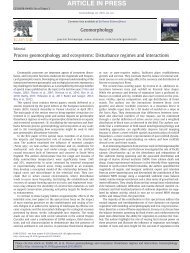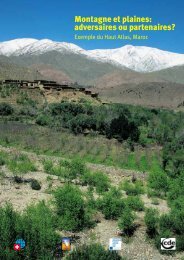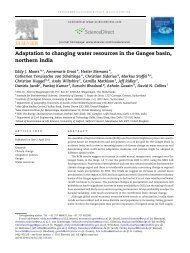(2010): Debris-flow activity along a torrent in - Dendrolab.ch
(2010): Debris-flow activity along a torrent in - Dendrolab.ch
(2010): Debris-flow activity along a torrent in - Dendrolab.ch
You also want an ePaper? Increase the reach of your titles
YUMPU automatically turns print PDFs into web optimized ePapers that Google loves.
Author's personal copy<br />
A. Sorg et al. / Dendro<strong>ch</strong>ronologia 28 (<strong>2010</strong>) 215–223 219<br />
Table 1. Former debris-<strong>flow</strong> <strong>activity</strong> left 69 visible growth defects and caused 200 growth reactions <strong>in</strong> 28 trees sampled <strong>along</strong> the Geisstriftba<strong>ch</strong><br />
<strong>torrent</strong>.<br />
Event (visible defects) Trees affected % of visible defects<br />
Tilt<strong>in</strong>g 28 41<br />
Stem burial 16 23<br />
Injury 14 20<br />
Exposure of roots 6 9<br />
Elim<strong>in</strong>ation of competitors 3 4<br />
Topped trees 2 3<br />
Total 69 100<br />
Response (growth reactions) Trees affected % of total responses<br />
Tangential rows of traumatic res<strong>in</strong> ducts 74 37<br />
Compression wood 41 20<br />
Growth suppression 42 21<br />
Growth release 25 13<br />
Injury 10 5<br />
Callus tissue 8 4<br />
Total 200 100<br />
<strong>Debris</strong>-<strong>flow</strong> frequency and sectors affected by<br />
events<br />
We reconstructed 13 debris-<strong>flow</strong> events for the period<br />
AD 1913–2006 based on 69 visible growth defects and 200<br />
growth disturbances observed <strong>in</strong> the 28 trees sampled. Table 2<br />
and Fig. 3 clearly illustrate that <strong>in</strong>dividual debris-<strong>flow</strong> events<br />
may <strong>in</strong>duce multiple reactions <strong>in</strong> a s<strong>in</strong>gle tree, result<strong>in</strong>g <strong>in</strong><br />
5–38 growth reactions identified per debris-<strong>flow</strong> event. At the<br />
same time, it becomes obvious that not all trees were equally<br />
affected by any given event. On average, 31% of the trees<br />
were show<strong>in</strong>g growth reactions after debris-<strong>flow</strong> <strong>activity</strong>.<br />
It also appears from the data that debris <strong>flow</strong>s did not<br />
equally affect the trees selected for analysis, and that differences<br />
exist depend<strong>in</strong>g on the elevation (i.e. lower vs. upper<br />
part of the <strong>ch</strong>annel) and on tree position (i.e. southern vs.<br />
northern <strong>ch</strong>annel levee). Those trees sampled <strong>in</strong> the lowermost<br />
part of the <strong>ch</strong>annel showed repeated signs of debris-<strong>flow</strong><br />
<strong>activity</strong> s<strong>in</strong>ce the beg<strong>in</strong>n<strong>in</strong>g of the tree-r<strong>in</strong>g-based reconstruction<br />
<strong>in</strong> 1913. Trees located <strong>in</strong> the upper part of the <strong>ch</strong>annel<br />
were considerably younger and debris <strong>flow</strong>s occurr<strong>in</strong>g before<br />
the mid-twentieth century were therefore not recorded by<br />
these trees. Tak<strong>in</strong>g <strong>in</strong>to account their shorter lifespan, these<br />
trees show more signs of geomorphic <strong>activity</strong> than trees <strong>in</strong><br />
the lower part. Our data <strong>in</strong>dicate that the trees grow<strong>in</strong>g on the<br />
southern levee <strong>in</strong> the lower part of the <strong>ch</strong>annel (1280 m a.s.l.)<br />
were disturbed by 11 out of 13 debris-<strong>flow</strong> events. Other trees<br />
grow<strong>in</strong>g <strong>in</strong> the lower part (1300 m a.s.l.), but on the northern<br />
levee show growth anomalies for five out of six debris <strong>flow</strong>s<br />
after 1970.<br />
Disturbance events caused by <strong>in</strong>dividual debris <strong>flow</strong>s can<br />
be categorized <strong>in</strong>to different spatial patterns, with subsequent<br />
events regularly affect<strong>in</strong>g the same group of trees.<br />
Fig. 4A demonstrates that a debris-<strong>flow</strong> event <strong>in</strong> 1957 left<br />
signs only <strong>in</strong> 6 out of 18 trees grow<strong>in</strong>g <strong>in</strong> the southern levee,<br />
but did not apparently cause growth defects to trees stand<strong>in</strong>g<br />
Fig. 3. (A) Cross-section and (B) growth curves of a heavily affected Larix decidua Mill. Dur<strong>in</strong>g a debris-<strong>flow</strong> event <strong>in</strong> 1957, the tree was<br />
<strong>in</strong>jured and tilted by a debris-<strong>flow</strong> event. As a result, the wound was closed on the upslope side and the tree formed compression wood on the<br />
downslope side of the trunk. The growth reduction <strong>in</strong> 1966 orig<strong>in</strong>ates from a lar<strong>ch</strong> budmoth year.






